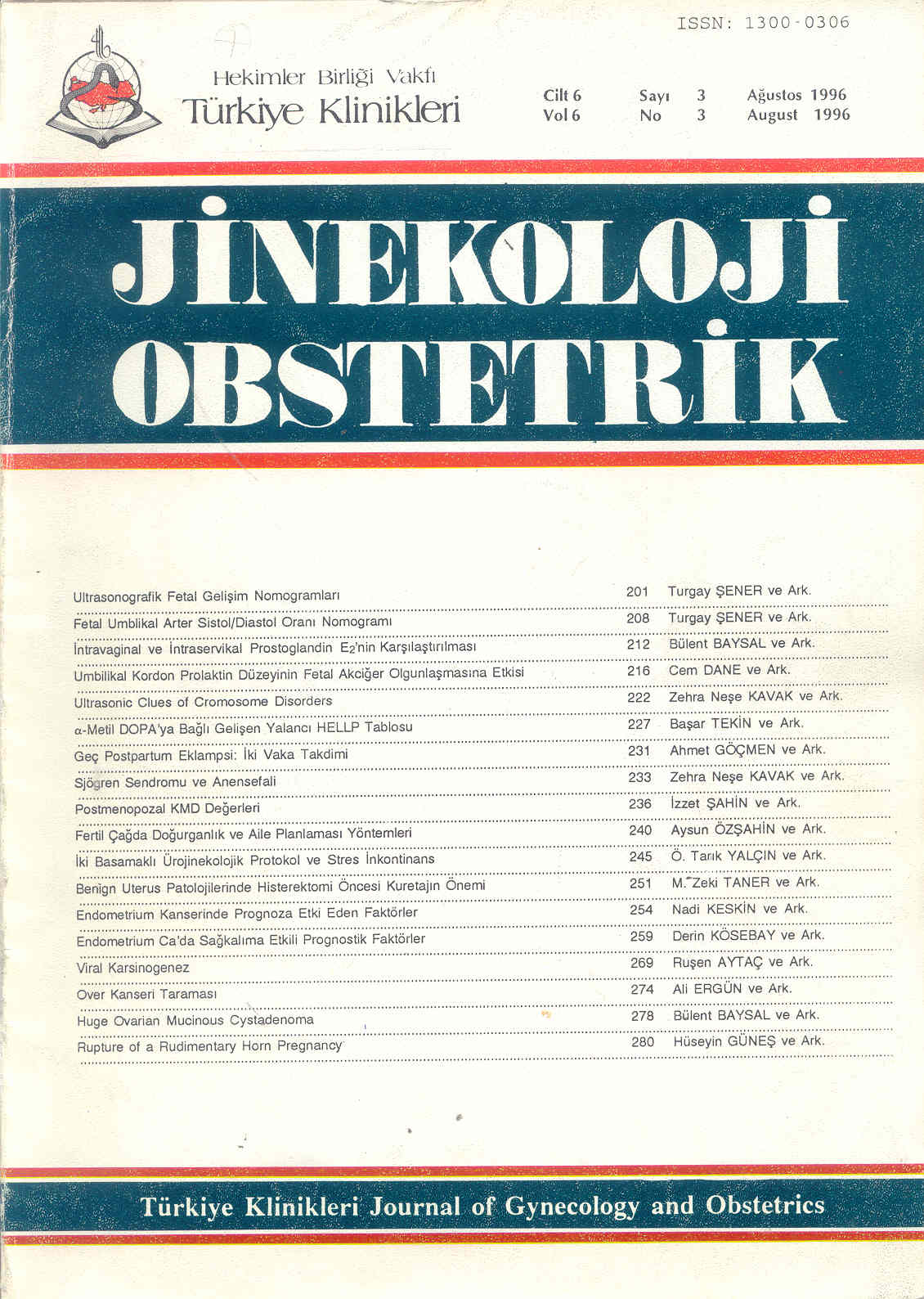Open Access
Peer Reviewed
ARTICLES
3343 Viewed1113 Downloaded
Are Fetal Growth Nomograms Different At Osman Gazi University Obstetrics Population?
Osman Gazi Üniversitesi Obstetrik Populasyonunda Ultrasonografik Fetal Gelişim Nomogramları Farklı mı?
Turkiye Klinikleri J Gynecol Obst. 1996;6(3):201-7
Article Language: TR
Copyright Ⓒ 2025 by Türkiye Klinikleri. This is an open access article under the CC BY-NC-ND license (http://creativecommons.org/licenses/by-nc-nd/4.0/)
ÖZET
Amaç: Literatürde ve ultrasonografi cihazlarının programlarında mevcut olan fetal gelişme nomogramları ölçüm yapılan toplumun gerçek değerlerini yansıtmayabilir. Çalışmamızda kendi obstetrik populasyonumuzda ultrasonografi ile biparietal çap, fetal abdominal çevre, humerus uzunluğu ve femur uzunluğu ölçerek kendi nomogramlarımızı hazırladık. Ortalama değerleri diğer çalışmaların ortalamaları ile kıyasladık. Çalışmanın Yapıldığı Yer: Osman Gazi Üniversitesi Tıp Fakültesi, Kadın Hastalıkları ve Doğum Anabilim Dalı, Eskişehir. Materyel and Metod: Poliklinikte muayene edilen obstetrik populasyonda 20. gebelik haftasından itibaren ultrasonografik olarak biparietal çap, fetal abdominal çevre, humerus uzunluğu ve femur uzunluğunu ölçülerek beşinci, onuncu, ellinci, doksanıncı ve doksanbeşinci persentiller hesaplandı. Bu değerler nomogram haline getirildi. Ölçüm ortalamaları bulunarak literatürdeki yayınlar ile karşılaştırıldı. Bulgular: Toplam 646 gebede ölçümler yapıldı. Biparietal çap ve fetal abdominal çevre ölçümlerinde diğer toplum ortalamalarına göre önemli farklar bulunmadı. Humerus uzunluğu ve femur uzunluğu ölçümlerinde bazı çalışmalara göre gebeliğin 34. haftası civarından başlayan bir yavaşlama izlendi. Sonuç: Fetal gelişim nomogramları toplumlar arasında farklılık gösterebilir. Her toplumun kendi verileri doğrultusunda hazırlanan gelişim eğrilerinin kullanmasının uygun olduğu kanısındayız.
Amaç: Literatürde ve ultrasonografi cihazlarının programlarında mevcut olan fetal gelişme nomogramları ölçüm yapılan toplumun gerçek değerlerini yansıtmayabilir. Çalışmamızda kendi obstetrik populasyonumuzda ultrasonografi ile biparietal çap, fetal abdominal çevre, humerus uzunluğu ve femur uzunluğu ölçerek kendi nomogramlarımızı hazırladık. Ortalama değerleri diğer çalışmaların ortalamaları ile kıyasladık. Çalışmanın Yapıldığı Yer: Osman Gazi Üniversitesi Tıp Fakültesi, Kadın Hastalıkları ve Doğum Anabilim Dalı, Eskişehir. Materyel and Metod: Poliklinikte muayene edilen obstetrik populasyonda 20. gebelik haftasından itibaren ultrasonografik olarak biparietal çap, fetal abdominal çevre, humerus uzunluğu ve femur uzunluğunu ölçülerek beşinci, onuncu, ellinci, doksanıncı ve doksanbeşinci persentiller hesaplandı. Bu değerler nomogram haline getirildi. Ölçüm ortalamaları bulunarak literatürdeki yayınlar ile karşılaştırıldı. Bulgular: Toplam 646 gebede ölçümler yapıldı. Biparietal çap ve fetal abdominal çevre ölçümlerinde diğer toplum ortalamalarına göre önemli farklar bulunmadı. Humerus uzunluğu ve femur uzunluğu ölçümlerinde bazı çalışmalara göre gebeliğin 34. haftası civarından başlayan bir yavaşlama izlendi. Sonuç: Fetal gelişim nomogramları toplumlar arasında farklılık gösterebilir. Her toplumun kendi verileri doğrultusunda hazırlanan gelişim eğrilerinin kullanmasının uygun olduğu kanısındayız.
ANAHTAR KELİMELER: Fetal gelişim, biparietal çap, fetal abdominal çevre, humerus uzunluğu, femur uzunluğu
ABSTRACT
Objective: The fetal growth nomograms that can be seen in the textbooks and ultrasonographic software may not be concordant with the nomograms of the population at which the measurements are obtained. In this study, we aimed to prepare the nomograms of the biparietal diameter, fetal abdominal circumference, humerus length and femur length in our obstetrics population, and to compare the mean values with the other studies. Institution: Osman Gazi University, Gynecology and Obstetrics Department, Eskişehir Material and Methods: Ultrasonographic measurements of the biparietal diameter, fetal abdominal circumference, humerus length and femur length were obtained in our obstetrics population, starting from 20th gestational week. Fifth, tenth, fiftieth, ninetieth, and ninetyfifth percentiles were calculated and nomograms were prepared. Mean values were compared with the data in the literature. Results: Measurements were obtained from 646 patients. No difference in the biparietal diameter and fetal abdominal circumference measurements were detected with the mean values of the other studies. A slight deterioration was observed in humerus length and femur length measurements begining from thirtyfourth gestational week, when compared with some studies. Conclusion: Fetal growth nomograms can be different between populations studied. We think that spesific growth curves should be used in different populations.
Objective: The fetal growth nomograms that can be seen in the textbooks and ultrasonographic software may not be concordant with the nomograms of the population at which the measurements are obtained. In this study, we aimed to prepare the nomograms of the biparietal diameter, fetal abdominal circumference, humerus length and femur length in our obstetrics population, and to compare the mean values with the other studies. Institution: Osman Gazi University, Gynecology and Obstetrics Department, Eskişehir Material and Methods: Ultrasonographic measurements of the biparietal diameter, fetal abdominal circumference, humerus length and femur length were obtained in our obstetrics population, starting from 20th gestational week. Fifth, tenth, fiftieth, ninetieth, and ninetyfifth percentiles were calculated and nomograms were prepared. Mean values were compared with the data in the literature. Results: Measurements were obtained from 646 patients. No difference in the biparietal diameter and fetal abdominal circumference measurements were detected with the mean values of the other studies. A slight deterioration was observed in humerus length and femur length measurements begining from thirtyfourth gestational week, when compared with some studies. Conclusion: Fetal growth nomograms can be different between populations studied. We think that spesific growth curves should be used in different populations.
MENU
POPULAR ARTICLES
MOST DOWNLOADED ARTICLES





This journal is licensed under a Creative Commons Attribution-NonCommercial-NoDerivatives 4.0 International License.










